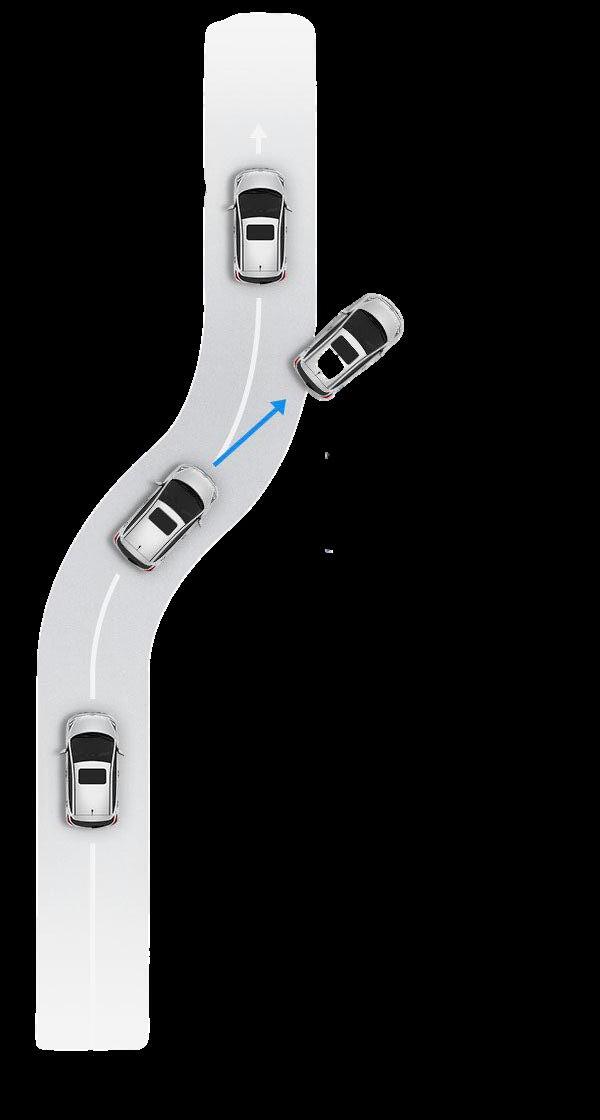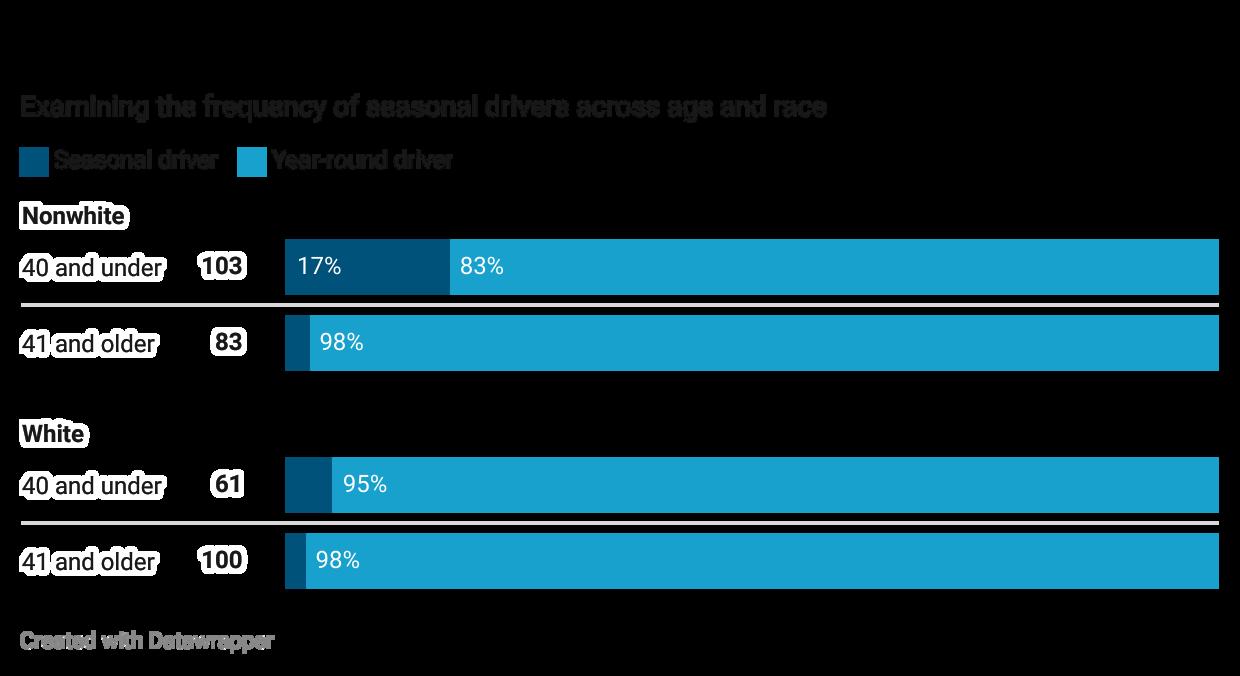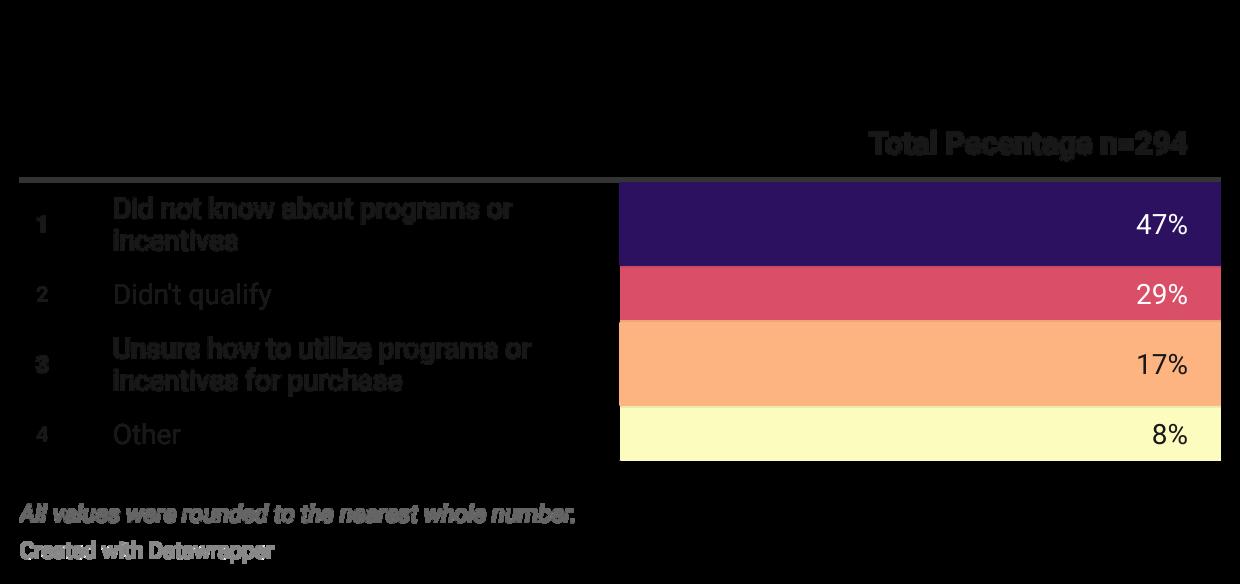

CALIFORNIA RIDESHARE ELECTRIFICAT RESEARCH




Report Objectives
To increase the electric vehicle (EV) market share, EVNoire composed a comprehensive study of California rideshare driver needs, challenges and insights, on EV adoption.
The Project Team identified the barriers and facilitating factors to electric vehicle adoption for California rideshare drivers.

Based on these findings, the team created recommendations to assist our industry partners in bolstering EV adoption amongst rideshare drivers.

Gig-Economy Labor Force
California’s gig-economy labor force consists of roughly 1.3 million part-time and full-time workers*.
Working drivers use their vehicles to generate an income, making them acutely attuned to the vehicle market.


2: Rideshare
Behavior

Rideshare Experience
Seasonal Work Patterns

Highest propensity for seasonal driving Nonwhite participants 40 and under who drove seasonally, were 3x higher than white participants

“I decided to work here seasonally so I don't have to leave my car sitting for a long time. I just sold my car. It was just pretty convenient that I just come back and just go rent a car and then give it back, and then I have to worry about it, for till I come back inside the country, you know. I have a dual citizenship. SoI decided after the pandemic, like I can work somewhere a little cheaper and just come back here. Work seasonal. That's what I do. So very attractive because of that.”

Rideshare Experience
Employment status
2 in 3 rideshare drivers are part-time.
Central Valley had 17% more part-time drivers than average



Rideshare Experience:
Employment History

Rideshare drivers in the survey were seasoned drivers:
Two-thirds of drivers worked 3 years or more
Most common employment timeframe was 6 years or more
37% of the average population
40% in regions such as Northern California.
This region should be the focus of recruitment and retention efforts.

Rideshare Experience
Gig Economy
Difference in transportation as a service (TaaS) platforms among drivers of different demographics, indicating different use cases for drivers on these platforms


Vehicle Type
Overview

Among the sample population, over half of drivers were ICE vehicle drivers, a share that was larger in Central Valley (69%) and lower in Northern California (46%).

Rideshare Trip Preferences

380 participants sampled
78% listed frequenting residential areas
Options were chosen at a consistent rate
Recreational activities were lowest with 42%
Drivers are more likely to have a diverse mix
To generate the highest income
Average selection choice for the question
7 out of 13 possible selections

Rideshare Trip Hesitations
380 participants sampled
24% are hesitant to trips in high-traffic areas
18% are hesitant for long-distance trips
Consistent rates across other options
Need for a balanced approach
Driver preferences impact the availability of rides in specific areas or for particular trip types
Addressing these preferences through...
Incentives
Improved compensation
Features allowing drivers to express preferences
Enhance availability & reduce wait times


Vehicle Rental Program


3: Vehicle Considerations


Motivators for EV Adoption

88 sampled
Respondents prioritize reduced cost of fuel for EVs
Aligns with general perception that EVs have the lowest operating costs.

Annual Vehicle Ownership Cost Breakdown








Barriers to Program Use for EV Purchase
Distribution of Ethnicity Among Program Barriers




Barriers to Driving an EV


4: Charging Capacity


Time Spent at Charging Station
88 sampled
High Income participants charge their EVs at home 50% or more of the time at a higher rate than other income groups


Public Charging Challenges


Public Charging Challenges


5: Information Sources


Information Sources


6: Qualitative Findings
EV Motivators and Concerns


Motivators: Environmental Impact

Reduced vehicle emissions
Lower vehicle maintenance costs
Earn extra income via rideshare App incentives
Cost savings of electricity compared to gasoline
“A mi me gustaria el proximo ano empezar o incluso este ano, si veo que todo mejora y lo hago luego porque la verdad debemos pensar mucho también en la mañana. Es un poquito corny, pero también en el planeta hay mucha destrucción ahorita del planeta. Y eso es algo que podemos empezar uno por uno, empezar a mejorar, nuestro futuro o el futuro de los niños”
I would like to start next year, even this year, if everything would to improve I would do it. Because the truth is we need to think in the tomorrow. It’s a little corny, but there's a lot of destruction of the planet right now. And it’s something we could start, to begin improving our future and the future of our kids.“

Motivators: Fuel Cost

71% of ICE drivers prioritized the reduced cost of fuel
Economic considerations help with decisions
EVs have lower operating costs
“I spend about $800 a month on gas, about $200 a week. So I got solar panels installed on my house last year. Mmhmm. <affirmative>, and that's free fuel for me. You know, I don't pay anything. I get a credit back every month, so that's more money in my pocket. So my next vehicle will definitely be an EV. Okay. Even though I get really good gas mileage on that Kia mm-hmm. <affirmative>. why pay for gas if you don't have to?”

Motivators - Rider Reactions
Positive Rider Reactions
Lack of engine noise
In-vehicle technology
“I found like since I've been driving, I also have a Tesla model 3, and like it's a conversation piece with my passengers, you know, people get in and like a lot of people have never been in a Tesla. And so. you know, if we're on a 20 min drive or something, I can spend almost the entire time in the car sort of showing off the features and stuff you know …I put it in full self driving, or I show them the the different things on the screen.”
Instant acceleration
Futuristic aesthetics


Concerns: All Drivers Charging Stations
Drivers look for charging stations that are:
Abundant
Safe Functioning
Waiting on charging stations presents two challenges
Time commitment Safety concerns.

And what I don't want to do is make it where it, it increases my day or my time or my, now I gotta sit and wait for something to charge. That's the point why I like driving or one of the reasons is because I turn the app on and I could go from wherever I am. I don't want to have to add time now I gotta look for a chart. Now I don't feel like all of that.

C a g g es a ge o 30 u es o a coup e o ou s depe d g o
An admittedly fragmented charging ecosystems Type of EV a rideshare driver has

Charging is perceived as a significant hindrance to productivity and generating income


Concerns: Safety
Drivers expressed concern about the safety of charging stations.
Especially at night rideshare drivers encounter dimly lit or seemingly unsafe charging locations.
“...and how inconvenient it would be to either have to find a spot to charge and wait for the charger. And then also there are just places in LA I don't want to sit for 30 minutes in my car. Especially late at night … or even during the day. Yeah you know, just like there are places in the LA I don't even drive to or take trips to, so why would I want to have to maybe get stuck there trying to look for a charger and charge my car”


Concerns - Cost vs. Profit
A worry of drivers is the purchase or rental cost of EVs compared to the profit for ridesharing EVs tend to be more costly
Price parity is expected to occur ~2027
“The other thing that's always been for me is the range of it. Cuz some days I can drive hundreds of miles. Like I like to go down to Orange County when they're busy down there Cause it's easier to get around like July 4th, there's gangbusters down there for earning and I can't think about having to stop for a hal hour or an hour to try and charge. So I like the reliability of gas”


Concerns Additional Trip Strategy
EV Owners and Renters expressed that additional time and effort to plan out efficient charging logistics for rideshare driving is a challenge. Some participants embraced the challenge, some were a bit less enthused about the extra planning and strategizing needed.

“If my charge is low…depending on how low it is. 30 minutes to 40 minutes that's adding to my day of me being gone from my family as opposed to when I had my gas car. I can, even if I took a ride and I'm like, oh, I'm low… I can stop real quick, and it's a 5 minute fill up”

Additional Findings
Connectivity
“I think this would be just an awesome feature in both apps, if like, they could show where charging stations were within the app like map, like a lot of times if I'm getting low…like really low or like whatever like 50 miles range left on my Tesla, and I get a ride I start trying to like look at the map when the request comes in and see. Oh, is that taking me close to one of the charging stations. But I have to kind of like mentally remember where the charging stations are, or sometimes, you know, I do look at like the GPS on my car and like map out in the Tesla where the charging stations (are) and kind of try to just do the math and the you know the whatever the logistical planning on my own. If it was in the app that would like make life so easier”

Bonuses
“
...if I do 50 rides in my Tesla a week, I get a $150 bonus and that's significant, you know, and you get a dollar extra per ride. So if you the more you know, money talks, and so the more they make it like financially beneficial to drive an EV the more it's going to bring people over, especially rideshare drivers.”

Electric Vehicle Rental Programs
Likes

“So we're with Hertz…in the Fresno area. Hertz, it's been great because you're in and out. If you get a EV rental or whatever it's like 15-20 minutes tops. So you're in and out… they’re on it. I mean, it's really expedient. They do a great job.”
Dislikes
”I mean, I think it's worded and um, it's worded and it's advertised in a way that makes it sound cost effective. Okay. But you're actually much better off just going out and buying the car yourself.”

7: Recommendation
 Rider Engagement Policy Programming Research
Rider Engagement Policy Programming Research

Rider Engagement & Outreach
Marketing Messaging - Actively motivators and concerns in mes
Motivators
Reduced vehicle emissions & envir
Gas price vs electricity
Lower vehicle maintenance cost
Earning extra income per trip and v
Positive passenger interaction and Concerns
Range limitations
EV profit margins
Additional time and effort to plan c


Policy
California Electric Vehicle Incentive Programs - Prioritize targeted awareness campaigns, advertising on rideshare apps, community organizations, and social media, ensuring equitable access to application processes for improved efficacy.
California offers many incentives, rebates, and programs to make purchasing EVs easier.
77% of participants did not use any of the provided programs
47% did not know about the programs or incentives
There is an opportunity to stack rebates and incentives
Increased awareness campaigns focused on
Simple, straightforward communication and direct calls to action
Easy access to starting the application processes for benefits
Provide in-person opportunities for education

Programming
Trip Preferences
-
Encourage comprehensive trip selection and enhanced compensation structures aimed to enhance service availability and reduce passenger wait times in areas drivers frequent less.
During analysis, participants were asked
“What type of locations do you make trips in/to frequently?”
“What types of trips are you most hesitant to accept as a rideshare driver?”
Areas frequented - Airports, hotels, and tourist attractions
Areas avoided - Long distance trips, bumpy/bad roads, areas without price surging
Address these preferences through:
Incentives
Improved compensation
Features allowing drivers to express preferences

Programming
Enhanced Offerings - Present enticing offerings and opportunities that cater to the needs of rideshare drivers.
Research participants expressed desire for rideshare platforms to increase or enhance their service offerings in the following ways: Seasonality Connectivity Bonuses Exclusive Charging Stations

Programming
Electric Vehicle Rental Programs -
Expand accessibility of EV rental programs through innovative and comprehensive cost structures and programs.
Research found most participants appreciated the concept of EV rentals
Rideshare drivers were hesitant to participate due to rental cost
Additional Areas for Improvement
Short Term/Temporary friendly rideshare rentals
Rideshare apps renting vehicles to drivers directly
An electric vehicle rental program helps drivers to purchase the vehicle later

Increased incentives from rideshare platforms to help drivers buy a vehicle

Research
Studies and Engagement - Continuously engage with rideshare drivers and assess the rideshare driver ecosystem.
The study allowed for key insights and understandings about the rideshare driver ecosystem
Our initial Focus Group survey had a response rate of 10%, more than 3x the industry avg. of 3%
Only 1% of drivers interested in the Focus Groups were able to participate
Consistent engagement and analysis of the changing needs and challenges are needed.
The industry can efficiently adapt to these developments and better facilitate EV growth
Some methods to achieve this goal include:
Surveys to further assess regional and city-specific trends
Focus groups to analyze the sentiments of drivers
In-person engagements to educate and connect with rideshare drivers

Conclusion
California is setting a great example for other states in the transition to elecric vehicles.
Although, achieving their 2035 goal of Zero Emission Vehicle (ZEV) will not be without its challenges.
Barriers to increased EV adoption include:
Vehicle cost
Range anxiety
Fragmented EV charging infrastructure
Additional strategizing and planning for fueling for fueling
Concerns about battery degradation
General lack of EV education


Excitement Around EVs is Surging
The study explored CA rideshare drivers... In-depth motivators
Preferences
Misconceptions
Apprehensions
What the electric vehicle industry needs to do, to achieve an even greater EV market share in the near future has been described.












